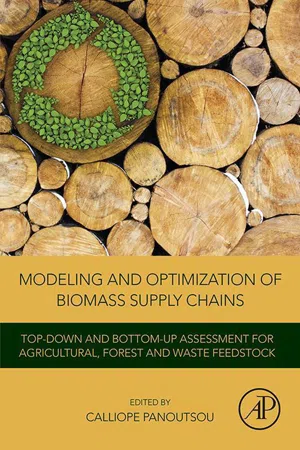
Modeling and Optimization of Biomass Supply Chains
Top-Down and Bottom-up Assessment for Agricultural, Forest and Waste Feedstock
- 292 pages
- English
- ePUB (mobile friendly)
- Available on iOS & Android
Modeling and Optimization of Biomass Supply Chains
Top-Down and Bottom-up Assessment for Agricultural, Forest and Waste Feedstock
About This Book
Modeling and Optimization of Biomass Supply Chains: Top Down and Bottom Up Assessment for Agricultural, Forest and Waste Feedstock provides scientific evidence for assessing biomass supply and logistics, placing emphasis on methods, modeling capacities, large data collection, processing and storage. The information presented builds on recent relevant research work from the Biomass Futures, Biomass Policies and S2Biom projects. In addition to technical issues, the book covers the economic, social and environmental aspects with direct implications on biomass availability.
Its chapters offer an overview of methodologies for assessing and modeling supply, biomass quality and requirements for different conversion processes, logistics and demand for biobased sectors. Case studies from the projects that inspire the book present practical examples of the implementation of these methodologies. The authors also compare methodologies for different regions, including Europe and the U.S. Biomass feedstock-specific chapters address the relevant elements for forest, agriculture, biowastes, post-consumer wood and non-food crops.
Engineers in the bioenergy sector, as well as researchers and graduate students will find this book to be a very useful resource when working on optimization and modeling of biomass supply chains. For energy policymakers, analysts and consultants, the book provides consistent and technically sound projections for policy and market development decisions.
- Provides consistent ratios and indicators for assessing biomass supply and its logistical component
- Explores assumptions behind the assessment of different types of biomass, including key technical and non-technical factors
- Presents the existing modeling platforms, their input requirements and possible output projections
Frequently asked questions
Information
Biomass Supply Assessments in Europe
Research Context and Methodologies
Abstract
Keywords
1.1 Research Context

Table of contents
- Cover image
- Title page
- Table of Contents
- Copyright
- List of Contributors
- Acknowledgments
- Chapter 1. Biomass Supply Assessments in Europe: Research Context and Methodologies
- Chapter 2. Existing Modeling Platforms for Biomass Supply in Europe
- Chapter 3. Lignocellulosic Biomass Quality: Matching Characteristics With Biomass Conversion Requirements
- Chapter 4. Modeling Biomass Logistics
- Chapter 5. Modeling Demand for Bio-Based Sectors
- Chapter 6. Assessing Lignocellulosic Biomass Potentials From Forests and Industry
- Chapter 7. Assessing Potentials for Agricultural Residues
- Chapter 8. Assessing the Potential From Bio-waste and Postconsumer Wood
- Chapter 9. Assessing the Potentials for Nonfood Crops
- Chapter 10. Research Overview, Gaps, and Recommendations
- Index